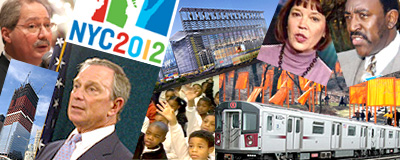
As 2005 drew to a close, one of the year’s biggest stories continued to unfold. In the early morning hours of December 20, the city’s transit workers walked off their jobs, setting off the city’s first transit strike in 25 years and leaving millions of Americans scrambling to get to work and school.
A transit strike any year would be a big story. But in 2005, the strike stood out because many of the other top stories of the year concerned things that did not happen -- Ground Zero did not make much progress, the West Side Stadium was not approved, the city was not selected as the site for the Olympics, the incumbent mayor was not kicked out, and there was no new terrorist attack in New York, despite such attacks in London and (last year) in Madrid. Indeed, some of the stories with the biggest impact on New Yorkers (or at least on New Yorkers' attention) took place outside the five boroughs -- in Washington, Baghdad, New Orleans, and elsewhere. It was, in reporter’s parlance, a slow news year in the Big Apple -- at least until late December.
One exception was the city’s newsrooms themselves. After New York Times reporter Judith Miller went to jail for refusing to disclose the name of a source, the paper found itself entangled in the investigation of high-level leaks in Washington and all too credulous acceptance of the Bush administration’s reasons for invading Iraq. Over at the Post, Lachlan Murdoch walked away from his job as publisher leaving his father, publishing tycoon Rupert Murdoch, to take up the job once. And Daily News editor-in-chief Michael Cooke has announced he will leave the paper early next year.
Here, not including such news about New York newsrooms, and in rough order of importance, are the Top 10 New York City stories of 2005:
1. Mayor Michael Bloomberg (And Everybody Else) Re-elected
 On an Election Day marked by low voter turnout, Republican Bloomberg defeated his Democratic rival Fernando Ferrer by 19.37 percentage points. To help achieve this victory, the billionaire spent $77,894,878 of his own money – or $103 for every vote he got. Ferrer spent about $9.5 million, or about $19 for every vote he got.
On an Election Day marked by low voter turnout, Republican Bloomberg defeated his Democratic rival Fernando Ferrer by 19.37 percentage points. To help achieve this victory, the billionaire spent $77,894,878 of his own money – or $103 for every vote he got. Ferrer spent about $9.5 million, or about $19 for every vote he got.
The defeat represented Ferrer’s third unsuccessful bid for Gracie Mansion. This time, though, the former Bronx borough president made it to the general election after he won the Democratic primary against three other major contenders. On primary night, Ferrer hovered around the 40 percent total he needed to avoid the runoff. Second place finisher Anthony Weiner, who had surged in the final days of the Democratic campaign, said he did not want a run-off, preferring to unify the party around Ferrer (and, some cynics said, ensure his own political future). The final tally showed Ferrer squeaking just ahead of 40 percent, negating the need for Weiner’s grand gesture.
Although the election dominated political headlines, much of the press treated an eventual Bloomberg victory as a foregone conclusion. Many of the city’s leading Democrats abandoned Ferrer, and few issues emerged to capture public attention.
In other municipal elections, all incumbents running again held on to their jobs – except for Allan Jennings of Queens whose tenure on City Council had been marked by accusations of sexual harassment and strange behavior. All the open City Council seats went to Democrats, enabling the party to hold on to its 48 to 3 edge in City Council.
One of the hottest contests came for Surrogate’s Court in Brooklyn, long a bastion for dispersing patronage and wealth to politically connected lawyers. In the contest to fill the seat left vacant after Judge Mitchell Feinberg was removed for misconduct, reform candidate Margarita Lopez Torres narrowly defeated the choice of the borough’s political establishment.
2. Transit Strike And Other Transit Troubles
 Members of the Transport Workers Union went out on strike on December 20, bringing a halt to the city’s subway system and buses. The union decided to launch the illegal strike -- the first transit strike in the city in 25 years -- after days of tense negotiations over wages, pensions, health benefits and work rules.
Members of the Transport Workers Union went out on strike on December 20, bringing a halt to the city’s subway system and buses. The union decided to launch the illegal strike -- the first transit strike in the city in 25 years -- after days of tense negotiations over wages, pensions, health benefits and work rules.
With the strike coming during the already busy holiday season, New Yorkers who normally ride mass transit scrambled to find other ways to get around town. The city instituted an emergency plan to help people, but drivers created gridlock on some roads, and riders reported confusion and congestion.
Labor problems were not the transit system’s only problem in 2005. The bombing of three subway stations and a bus in London on July 7 raised new concerns about the safety of New York’s mass transit system. Although the Metropolitan Transportation Authority had approved a $591 million security plan in 2002, at the time of the London attacks it had spent only a fraction of that amount – and that that had gone for consultants and more study. Responding to harsh criticism, the agency announced plans to improve security, deciding to pay defense company Lockheed Martin $200 million for a security and surveillance system at major bridges, tunnels and train and subway stations.
The police instituted searches of passenger bags and backpacks, a move challenged by the New York Civil Liberties Union but, so far at least, upheld in court.
In October, Mayor Michael Bloomberg temporarily increased security and told New Yorkers the subway system was facing a specific terrorist threat. A source in Iraq had reportedly told his U.S. government contacts that several men – some of whom may already have been in New York – planned to set off 19 bombs on the city's subways. Federal officials later determined that the threat had been fabricated.
3. Ground Zero -- Little Progress, Lots of Controversy
 Last spring, as planning for Ground Zero faltered once again, one observer wrote, “It’s striking that our parents and grandparents managed to win World War II in 44 months while we have not been able even to agree on a plan for what to do with Ground Zero.”
Last spring, as planning for Ground Zero faltered once again, one observer wrote, “It’s striking that our parents and grandparents managed to win World War II in 44 months while we have not been able even to agree on a plan for what to do with Ground Zero.”
2005 saw some progress. Ground was broken on the transportation hub downtown. The new building at 7 World Trade Center is virtually complete – but has no tenants. And work finally began on the memorial.
But overall planning for the site remained mired in controversy and confusion, with little common ground to be found at what many consider sacred ground.
Last spring, about 10 months after the cornerstone was laid for the Freedom Tower, the building went back to the drawing board after the police department expressed concerns about security at the building. Less than two months later, officials announced a new design. It met the police concerns but removed some trademarks of the original plan -- including the twist in the tower and the openwork at the bottom of the building. The tower will not be completed until 2010 at the earliest and no one knows who, if anyone, will rent space there.
The design problem spurred concern about the slow pace of overall planning for the site. Many blamed Governor George Pataki, saying the he was not paying attention. Perhaps in response, in October, Bloomberg, who until then had largely ignored Ground Zero, stepped into the breach. Challenging Pataki, Bloomberg called for removing developer Larry Silverstein from planning for the site and for building housing, not just office space (which no business seems to want to rent anyway). After his re-election, Bloomberg continued to press his involvement, appointing members of his administrations to the Lower Manhattan Development Corporation.
While some praised the major’s actions; others said he was creating more upheaval. And as he traveled around the country campaigning for president, Pataki vowed to stay involved at Ground Zero, perhaps setting the stage for a power struggle or simply for more inertia.
Also this year, the prospects faded for culture at Ground Zero. The Drawing Center withdrew from the site after families of victims of the 9/11 attacks questioned the political content of its exhibitions. Similar opposition prompted Pataki to overrule his own Lower Manhattan Development Commission and block plans for the International Freedom Center at the site. The decisions left the planned cultural building without any tenants, led many to question the role of the families in planning for Lower Manhattan and raised concerns about whether any bona fide cultural institution could withstand such scrutiny. Ironically, shortly after the museums withdrew, the Port Authority announced plans for a shopping mall near the site. So far, that idea has met with little, if any organized opposition.
4. State Politicians Stop West Side Stadium
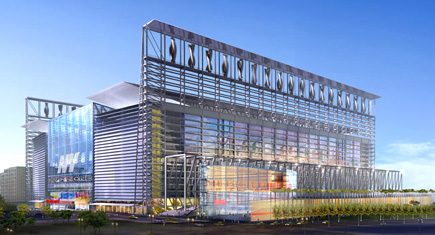
After almost four years, plans to build a football stadium on Manhattan’s far West Side came to an abrupt halt in June when the leaders of the state legislature blocked the project. Mayor Michael Bloomberg had proposed and energetically boosted the project, but its defeat probably helped ease his re-election by removing a major argument against him.
The stadium’s supporters said it would be key to the future of the far West Side, would provide a home for the Jets and was essential for the city’s hope for the 2012 Olympic games. But critics challenged the financing of the deal, claiming it was a giveaway for the Jets that would be of little, if any, benefit to most New Yorkers.
In the end, the project also fell victim to the continuing woes at Ground Zero. ''Am I supposed to turn my back on Lower Manhattan as it struggles to recover?'' Assembly Speaker Sheldon Silver, who represents Lower Manhattan and voted to block the stadium said. ''For what? A stadium? For the hope of bringing the Olympics to New York City?''
5. Nets, Mets, Yankees Plan New Stadiums
|
|
But other projects to provide new and improved facilities for New York teams survived and thrived in 2005.
Plans for an arena for the Nets basketball team in downtown Brooklyn, accompanied by a huge residential and commercial development, moved forward as the Metropolitan Transportation Authority agreed to sell development rights to the Atlantic rail yards to developer Bruce Ratner.
Beyond the stadium, plans for the 22-acre area changed during the year. In July, Ratner and architect Frank Gehry proposed 17 buildings, including some as high as 60 stories. Overall, the project would include as many as 7,300 apartment and, many believe, would transform Brooklyn – for better or worse.
As it has grown ever bigger, the $3.5 billion scheme has attracted more opposition. And before the project can become a reality, the same state panel that blocked the West Side Stadium must agree to support it. Opponents also plan to launch legal challenges.
In Queens, the Jets’ loss became the Mets’ gain. Following defeat of the West Side stadium, the city and the baseball team agreed that the Mets would build a new, $600 million privately funded stadium on the site of a parking lot at the current home of the Mets, Shea Stadium. The city will provide $160 million for infrastructure. If the city had gotten the Olympics, it would have used the new stadium for that – which is what some of Bloomberg’s critics said he should have planned on doing all along.
And once the Mets got a new stadium, the Yankees wanted one too – an $800 million structure, also privately funded, to replace the House that Ruth Built. The new stadium will be north of the current one, on what is now parkland. The city will spend $135 million, and the state about $70 million. The loss of about half of Macombs Dam and John Mullaly parks has spurred some community opposition to the new stadium.
But the largest sports facility now proposed for the city is a NASCAR track on Staten Island that would seat 80,000 people. Although the track would be privately funded and has some innovative features – such as virtually forcing fans to take mass transit to the races – it has attracted widespread opposition among Staten Islanders concerned about its effects on the local economy and on the island’s already horrendous congestion problems.
6. Olympic Bid Fails
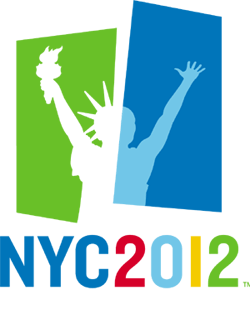 After a years of effort, lavish presentations, appeals from celebrities and much wining and dining, New York City’s bid to play host to the 2012 Olympic games failed. In July, the International Olympic Committee awarded the sports extravaganza to London. Among the five competing cities, only Moscow was eliminated from contention earlier than New York.
After a years of effort, lavish presentations, appeals from celebrities and much wining and dining, New York City’s bid to play host to the 2012 Olympic games failed. In July, the International Olympic Committee awarded the sports extravaganza to London. Among the five competing cities, only Moscow was eliminated from contention earlier than New York.
Bloomberg and his deputy mayor – and architect of the Olympic bid – Daniel Doctoroff blamed the city’s defeat on the collapse of the city’s plans to build the Jet’s stadium, which would also have served as the main Olympic venue, on Manhattan’s West Side. But even before the stadium fell through, many observers said New York’s bid could falter due to lukewarm support for the idea among New Yorkers and global antipathy to Bush administration policies. Of course, many of those same pundits also predicted Paris would get the games.
7. Student Test Scores Rise
|
|
City public schools students are doing better in reading and math, according to a spate of test results released in 2005. Third, fifth, sixth and seventh graders saw scores rise on their citywide English and math tests, as, for the first time ever, more than half met or exceeded standards. For example, 77 percent of fourth graders in the city met or surpassed state standards for math, a 9.3 point jump and almost double the statewide increase.
Bloomberg touted the scores as an endorsement for tougher standards, a uniform curriculum and not promoting struggling students. But others questioned any connection, noting that scores rose in other cities in the state that had not instituted such sweeping changes. And there were setbacks too. Most notably, scores dropped among eighth graders, indicating persistent problems in middle schools.
The release of federal scores later in the year added to the confusion. While New York City fared better than many other urban school districts, the scores rose far less than they had on New York State tests. Such results led some to wonder whether students were getting smarter –- or city tests were getting easier.
8. Clarence Norman Convicted
 In two separate trials, Assemblymember Clarence Norman, longtime leader of the Brooklyn Democratic Party, was convicted of felony charges arising from his handling of campaign contributions. The convictions came amid heightened concern over corruption in the city’s courts, particularly the selling of judgeships in Brooklyn.
In two separate trials, Assemblymember Clarence Norman, longtime leader of the Brooklyn Democratic Party, was convicted of felony charges arising from his handling of campaign contributions. The convictions came amid heightened concern over corruption in the city’s courts, particularly the selling of judgeships in Brooklyn.
After his first conviction in September, Norman had to resign from both the Assembly and his party post. He faces up to 15 years in prison and awaits two more felony trials.
But despite Norman’s downfall, some questioned whether anything -- other than the player’s faces -- would really change and found plenty of evidence to support their skepticism. Party leaders selected Reverend Karim Camara, a colleague of Norman’s father, to replace him in the Assembly. Geoffrey Davis, brother of the late City Councilmember James Davis who had clashed frequently with Norman, told the New York Sun that Camara’s selection resembled a “Mafia style” selection when “the Godfather goes to jail and picks his successor.”
And the county leaders selected Assemblymember Vito Lopez to replace Norman as Kings County Democratic leader. While Lopez promised reforms, many doubted his sincerity. “Meet the new boss, same as the old boss,” the Daily News entitled its editorial on Lopez. And although Brooklyn District Attorney Charles Hynes has essentially acknowledged judgeships are sold in his borough, he has not yet indicted anyone on charges of doing so.
Faced with such widespread allegations, Bloomberg has said he will make improving the selection of judges a priority in his second term.
9. Fulton Fish Market Leaves Fulton Street
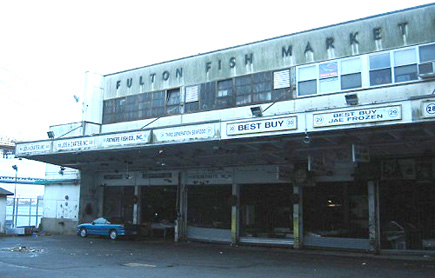
After 183 years, the Fulton Fish Market moved from its old outdoor location along the East River in Lower Manhattan to a new indoor facility in the Hunts Point section of the Bronx. The city first proposed the move in 1999 to bring industry to the Bronx, provide a more modern wholesale fish market and to improve the area around the old market as a residential and tourist neighborhood. Legal wrangling delayed the change, but it finally happened in mid November.
Many saw it as progress, with a sanitary facility replacing what many considered a smelly eyesore. But some had doubts. “The city is throwing away its history," said a fillet man named Bobby DiGregorio, known as Bobby Tuna, told the New York Times on one of Fulton Street’s last days. "One day, there's going to be a Banana Republic where I'm standing."
10. The Gates Come to Central Park
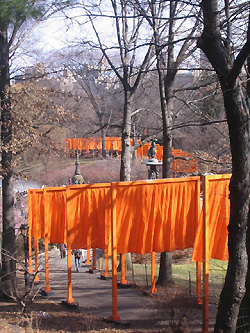 It took 26 years of planning, 5,290 tons of steel and cost as much as $21 million but finally on February 12, more than a million square feet of saffron fabric unfurled from 7,503 steel frames in a wintery Central Park. The Gates -- the work of artists Christo and Jean Claude -- had become a reality.
It took 26 years of planning, 5,290 tons of steel and cost as much as $21 million but finally on February 12, more than a million square feet of saffron fabric unfurled from 7,503 steel frames in a wintery Central Park. The Gates -- the work of artists Christo and Jean Claude -- had become a reality.
The installation of gates of varying sizes positioned along park walkways transformed the park for 16 days at its most austere time of the year. By the city’s account, the work attracted 4 million visitors to Central Park and boosted the city’s economy by $254 million.
There were, of course, naysayers. But many found it entrancing. Calling it a “gift package to New York City,” Times art critic Michael Kimmelman wrote The Gates “is a work of pure joy.”
We can all hope 2006 brings more of those.
Â









